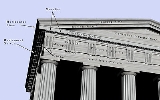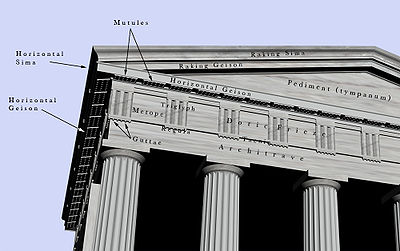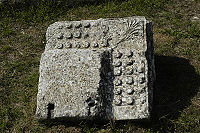
Geison
Encyclopedia

Entablature
An entablature refers to the superstructure of moldings and bands which lie horizontally above columns, resting on their capitals. Entablatures are major elements of classical architecture, and are commonly divided into the architrave , the frieze ,...
that projects outward from the top of the frieze in the Doric order
Doric order
The Doric order was one of the three orders or organizational systems of ancient Greek or classical architecture; the other two canonical orders were the Ionic and the Corinthian.-History:...
and from the top of the frieze course (or sometimes architrave) of the Ionic
Ionic order
The Ionic order forms one of the three orders or organizational systems of classical architecture, the other two canonic orders being the Doric and the Corinthian...
and Corinthan
Corinthian order
The Corinthian order is one of the three principal classical orders of ancient Greek and Roman architecture. The other two are the Doric and Ionic. When classical architecture was revived during the Renaissance, two more orders were added to the canon, the Tuscan order and the Composite order...
orders; it forms the outer edge of the roof on the sides of a structure with a sloped roof. The upper edge of the exterior often had a drip edge formed as a hawksbeak moldingto shed water; there were also typically elaborate moldings or other decorative elements, sometimes painted. Above the geison ran the sima. The underside of the geison may be referred to as a soffit
Soffit
Soffit , in architecture, describes the underside of any construction element...
. The form of a geison (particularly the Hawksbeak molding of the outer edge) is often used as one element of the argument for the chronology of its building.
Horizontal geison

Doric order

Triglyph
Triglyph is an architectural term for the vertically channeled tablets of the Doric frieze, so called because of the angular channels in them, two perfect and one divided, the two chamfered angles or hemiglyphs being reckoned as one. The square recessed spaces between the triglyphs on a Doric...
s and metope
Metope (architecture)
In classical architecture, a metope is a rectangular architectural element that fills the space between two triglyphs in a Doric frieze, which is a decorative band of alternating triglyphs and metopes above the architrave of a building of the Doric order...
s of the Doric frieze below. Each mutule typically had three rows of six gutta
Gutta
A gutta is a small water-repelling, cone-shaped projection used in the architrave of the Doric order in classical architecture. At the top of the architrave blocks, a row of six guttae below the narrow projection of the taenia and cymatium formed an element called a regula...
e (decorative conical projections) protruding from its underside. The gaps between the mutules are termed viae (roads). The effect of this decoration was to thematically link the entire Doric entablature (architrave, frieze, and geisa) with a repeating pattern of vertically and horizontally aligned architectural elements. Use of the hawksbill molding at the top of the projecting segment is common, as is the undercutting of the lower edge to aid in dispersing rainwater. In order to separate the geison from the frieze visually, there is typically a bed molding aligned with the face of the triglyphs.
Ionic and Corinthian orders
Horizontal geisa of these orders relied on moldings rather than the mutules of the Doric order for their decoration.Raking geison

Aedicula
In religion in ancient Rome, an aedicula is a small shrine. The word aedicula is the diminutive of the Latin aedes, a temple building or house....
of a scaenae frons (theater stage building). This element was typically less decorative than the horizontal geison, and often of a differing profile from the horizontal geison of the same structure. The difference is particularly marked in the Doric order, where the raking geison lacks the distinctive mutules. The raking sima ran over the raking geison as a decorative finish and, essentially, a rain gutter.

